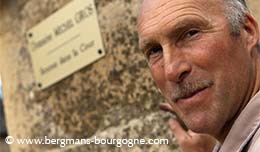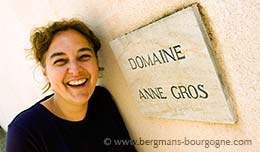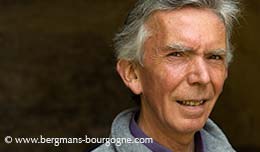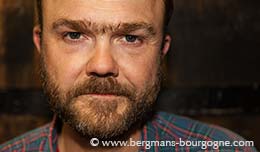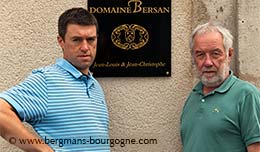
omaine Charton is firmly rooted Mercurey. Most of the bottles leaving the cellar have Mercurey labels. But the history of the domaine takes us to Savigny-lès-Beaune, where the grandfather of Vincent Charton had a few hectares of vines before he decided to accept a friend’s offer and relocate to the Côte Chalonnaise.
 – My grandfather was friends with Paul Bouchard, of Bouchard Ainé & Fils, who asked him if he was interested in becoming the manager of a domaine they had bought in Mercurey. He said yes and moved to Mercurey. For the money he saved he bought some vineyards, mainly regional appellation Bourgogne.
– My grandfather was friends with Paul Bouchard, of Bouchard Ainé & Fils, who asked him if he was interested in becoming the manager of a domaine they had bought in Mercurey. He said yes and moved to Mercurey. For the money he saved he bought some vineyards, mainly regional appellation Bourgogne.
Since then much has happened. Domaine Charton has grown to cover twelve hectares. Vincent’s father, Jean-Pierre Charton, succeeded his father as manager in Mercurey and continued building a family domaine in his spare time.
– My father worked in the vineyards and in the cellar, but he was not involved in marketing the wines, explains Vincent Charton. He worked in a large house in the middle of the village. Since Boisset bought it it is called Le Clos Rodet. It is next to the town hall and it used to be called Le Clos La Marche, since it was also the owner of the vineyard of the same name.
 As manager Jean-Pierre Charton was responsable for 35 hectares. In addition to that he had brought additional vineyards to the family domaine, which at the time had reached a total of eight hectares. Bouchard eventually sold the domaine to Louis Max and recently it became Domaine Mia.
As manager Jean-Pierre Charton was responsable for 35 hectares. In addition to that he had brought additional vineyards to the family domaine, which at the time had reached a total of eight hectares. Bouchard eventually sold the domaine to Louis Max and recently it became Domaine Mia.
– I arrived here in 2011 when I was 25 years old, continues Vincent Charton. I wasn’t really interested in succeeding my father as manager. That domaine was simply too big. It was more of a farmer’s job than something for a winemaker with a passion. Also, I had enough surface area here at the family domaine to make a living. We had bought Mercurey premier cru La Chassière and Mercurey Chapitre. So today we produce about 50 000 bottles annually.
 – The work my father had done up until that point was immense. He had been running two domaines, not to mention the fact that he planted between 80 and 90 hectares of vineyards in Mercurey. He was tired, so immediately when I finished wine school the question was raised. It was time for a new generation to take on the family domaine, and would I do it?
– The work my father had done up until that point was immense. He had been running two domaines, not to mention the fact that he planted between 80 and 90 hectares of vineyards in Mercurey. He was tired, so immediately when I finished wine school the question was raised. It was time for a new generation to take on the family domaine, and would I do it?
At this point the majority of the work creating today’s Domaine Charton had already been done by Jean-Pierre Charton. As Vincent Charton points out the groundwork, and more than that, had been done. For him it was more about adjustments and getting to know the domaine.
– Basically, in the vineyards I haven’t changed anything, he says. In terms of vinification there have been some adjustments, things that had to be done due to climate change.
 Unlike many other domaines in Burgundy, which often have wines from several villages in their portfolio, Domaine Charton is focused on Mercurey only. Even the regional appellation vineyards are in Mercurey.
Unlike many other domaines in Burgundy, which often have wines from several villages in their portfolio, Domaine Charton is focused on Mercurey only. Even the regional appellation vineyards are in Mercurey.
The premier cru Clos du Roy comes in both colours here. Then there are another two premier crus, both red, La Chassière and Les Naugues. With well over 600 hectares Mercurey is only second to Chablis in terms of size and you’ll find the three premier crus of the domaine in distinctly different parts of the appellation. Les Naugues is very close to the winery. Clos du Roy is further south. And La Chassière is at the southernmost tip, in the Saint-Martin-sous-Montaigu part of the appellation.
 – We are right in the middle of Clos du Roy, says Vincent Charton. Below the premier cru La Mission, where you have the steepest part of Clos du Roy. This a very nice terroir, one of the five historic clos in Mercurey. La Mission is more stony. In Clos du Roy you have clay and blue marl. In total Clos du Roy covers about ten hectares and we are six different owners. I have 1.10 ha, of which 0.27 ha is planted with chardonnay.
– We are right in the middle of Clos du Roy, says Vincent Charton. Below the premier cru La Mission, where you have the steepest part of Clos du Roy. This a very nice terroir, one of the five historic clos in Mercurey. La Mission is more stony. In Clos du Roy you have clay and blue marl. In total Clos du Roy covers about ten hectares and we are six different owners. I have 1.10 ha, of which 0.27 ha is planted with chardonnay.
It was Jean-Pierre Charton who planted the chardonnay vines in the 1960s. They are on the top part, while the pinot noir part is further down. There are only two domaines who produce white Clos du Roy, Charton and Chanzy.
– You have to realise that in 1960s you had to be a bit crazy to plant chardonnay in Clos du Roy, a fairly well known appellation, known for its reds. The market favoured reds, that was what the demand looked like. And because of that premier crus like Les Crêts and Le Clos des Barraults were replanted with pinot noir in the 1970s. Today the white Mercurey is returning. Parts of the slopes are being replanted and the domaines are finding a balance between red and white.
 La Chassière is a slope facing straight south. Not very deep friable soil. It’s quite similar to the soil in Les Chaumes, where the domaine’s Bourgogne Chardonnay comes from. Vincent Charton bought this parcel in 2010 and replanted it.
La Chassière is a slope facing straight south. Not very deep friable soil. It’s quite similar to the soil in Les Chaumes, where the domaine’s Bourgogne Chardonnay comes from. Vincent Charton bought this parcel in 2010 and replanted it.
The southeast-facing Les Naugues is Domaine Charton’s smallest premier cru. Just 900 bottles leave the cellar each year.
One step down, on village level, there are two red cuvées (there is a third, the Empreinte cuvée, but it’s not produced every year) – the Mercurey Vieilles Vignes and the Mercurey Vigne du Chapitre.
The old vines cuvée is a blend three parcels, two of which are in the premier cru Les Vellées. The third parcel is in the middle of Les Chavances, which is immediately east of Les Vellées.
Vigne du Chapitre is a bit further north. Right next to the main street. There is more clay than in Chavances. But in both cases the soil is not very deep, just 1.5 metre. For Vigne du Chapitre Vincent Charton uses 40 per cent whole bunches.
© 2024 Ola Bergman










